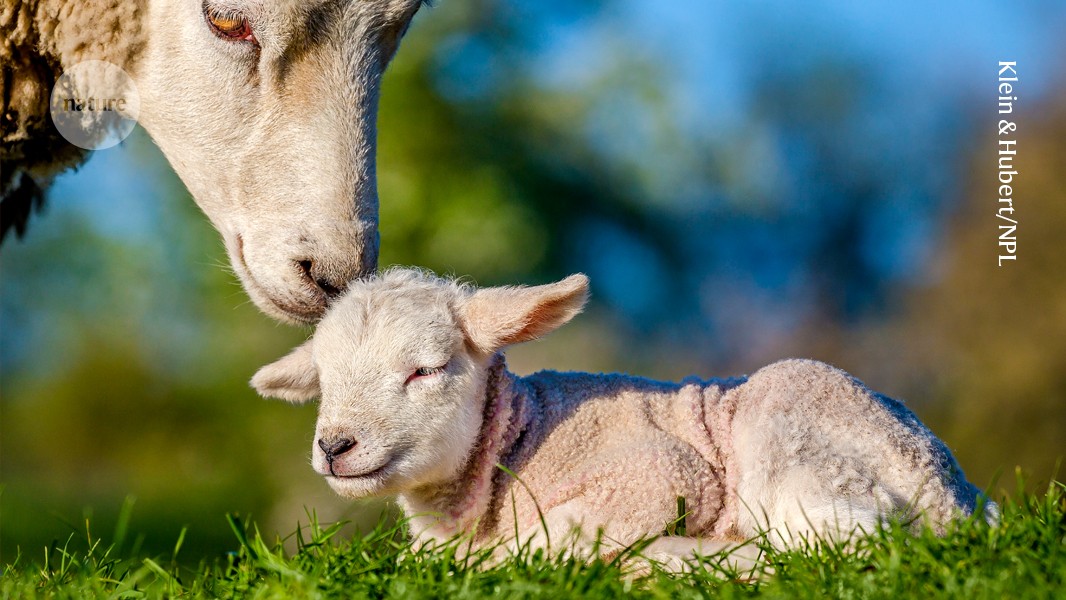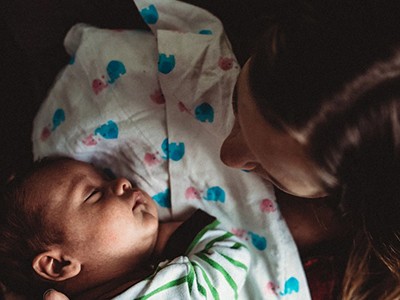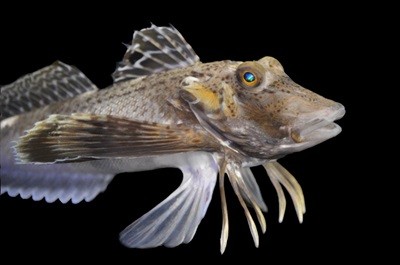Elephants are pregnant for up to two years. Females of some fish species starve for weeks while holding dozens of eggs and hatchlings inside their mouths. And pregnant humans commonly endure months of fatigue and nausea. These are just a few ways in which reproduction demands energy from mothers across the animal kingdom.
But researchers might have vastly underestimated the energy it takes to reproduce, according to Dustin Marshall, an ecologist and evolutionary biologist at Monash University in Melbourne. Australia.
The extra energy it takes a human to produce a baby could be as much as 24 times more than some influential mathematical models had estimated, suggest Marshall and his colleagues in a study published in May
1
. For animals that rely on external heat sources to regulate their body temperature, called ectotherms, the difference is smaller. For the pampas snake (
Tomodon dorsatus
), for example, the value is around four times more. And for a species of seawater fish called the capelin (
Mallotus villosus
), it is twice more.
How pregnancy transforms the brain to prepare it for parenthood
These findings are not merely a curiosity. Researchers use mathematical models to examine how energy needs change during animal lifespans — during growth, feeding and reproduction, for instance. And these, in turn, feed into explanations of why species evolve in the way that they do, such as the number of offspring that they have, or the benefits of live births over laying eggs.
The work by Marshall’s team suggests that these models’ estimates of the energy requirements of reproduction have often overlooked or underestimated the energy spent by mothers in making and carrying their young — sometimes referred to as the ‘indirect’ costs of reproduction, as opposed to the direct cost, the energy invested and stored in the offspring. It is akin to assuming that the energy needed to make a doughnut is equal to the calories in the doughnut itself, and ignoring the fuel required to cook it.
The results, says Marshall, could influence theories about aspects of animal lifestyles, and improve predictions about how animals will respond to climate change.
“The magnitudes of these indirect costs are really quite stunning,” says ecologist and evolutionary biologist Lauren Buckley at the University of Washington in Seattle.

Pregnancy in humans costs an extra 208,000 kilojoules (50,000 kilocalories), according to study estimates.
Credit: Jeffrey Greenberg/Universal Images Group/Getty
How to measure energy use
In 2020, Marshall’s team decided to comb the literature for dozens of studies from the 1930s to the 2000s, that had measured either the rate of energy use in pregnant and non-pregnant females or the energy stored directly in the offspring. Overall, the team collated enough data to calculate the indirect and direct costs of reproduction for 81 species, ranging from microscopic animals called rotifers to fishes, snakes and humans.
For the human data, for instance, the researchers drew on a 2004 paper that measured the metabolic rate of humans before and during pregnancy
2
. They used this to estimate the extra energy required during nine months of pregnancy — the indirect costs — and combined that with estimated direct costs, such as the total energy content of a newborn baby.
Metabolic-rate data are not easy to gather. To measure the energy used by pregnant females, researchers track how much oxygen they are using and how much carbon dioxide they are exhaling.
This fish’s legs are made for walking — and tasting the sea floor
In a 2007 study, for instance, Ryan Samuel at South Dakota State University in Brookings and his colleagues put five pregnant pigs in individual airtight glass chambers with tubes carrying samples of air in and out, for one day at a time
3
. “As the graduate student on the project, I had the overnight shifts to stay and monitor the animals,” says Samuel, who had to check that the pigs were comfortable and the equipment was working.
Besides the night shifts, other issues make it hard to track energy use during pregnancy for periods much longer than one day. “If it was longer than that, you’d have to figure out a way to remove the poo and waste from the pigs without breaking the seal of the chamber,” he says. It’s not surprising that such measurements are rare in the literature, says Marshall.
Instead, modellers have found it easier to calculate the energy stored in offspring — by simply estimating the amount of bone, fat and protein in the bodies of offspring and combining that with the known energy content of those components. Modellers assumed that this equalled the energy cost of reproduction. Some models have included estimates of indirect costs, but these costs were assumed to range from just 5% to 25% of the total energy spent on reproduction, depending on the model.
Energy imbalance
Marshall’s team, however, found that the indirect costs of reproduction are often much higher than the direct costs — contrary to the assumptions of earlier models (see ‘Costs of making a baby’).
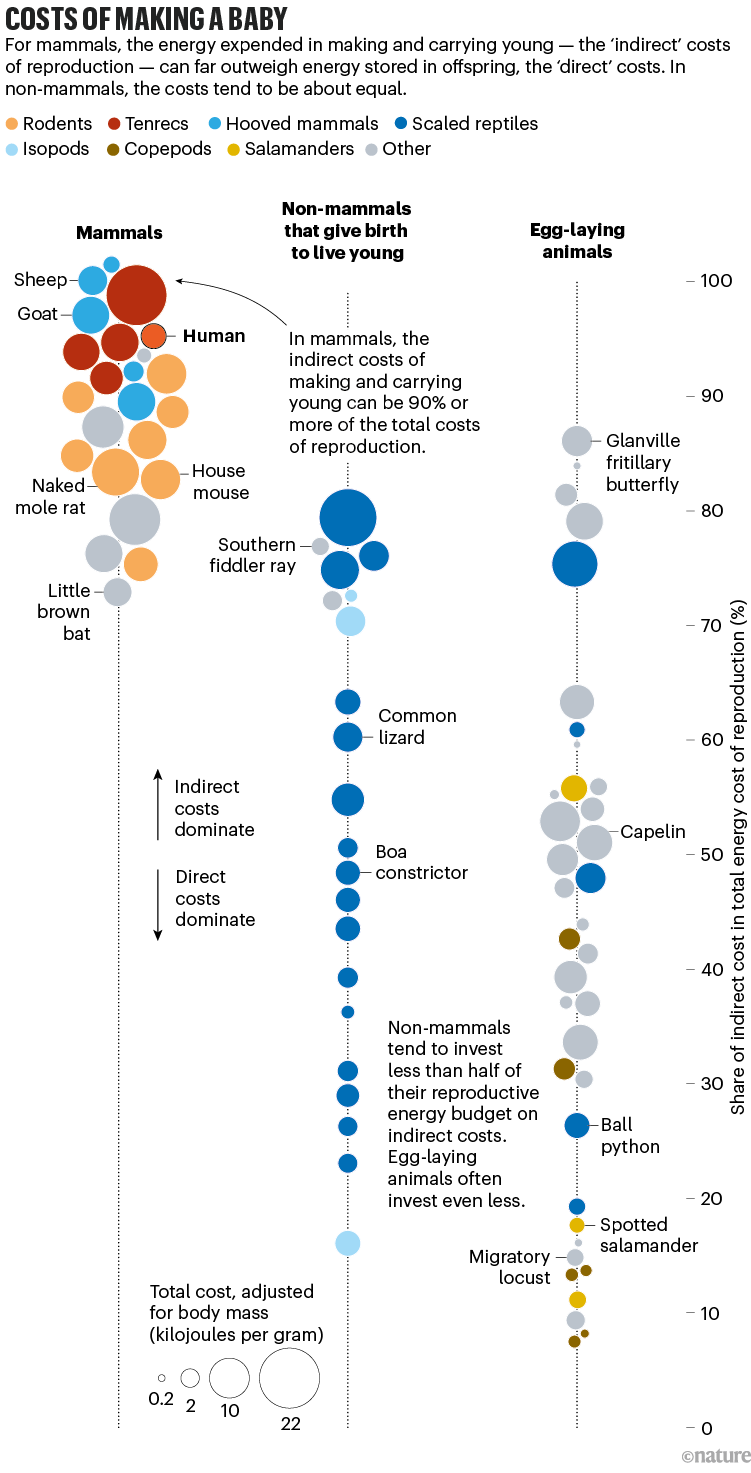
Source: Ref. 1
In mammals, which often grow placentas to provide oxygen and nutrients and to remove waste, and which maintain a stable internal body temperature, the researchers found that the indirect costs made up roughly 90% of the total energy costs of reproduction. Just 10% of the total energy is contained in the offspring. In humans, 96% of the 208,000 kilojoules (or nearly 50,000 kilocalories) required for reproduction is taken up by indirect costs.
By contrast, ectotherms invest less of their total reproductive energy budget in indirect costs, the researchers found. In ectotherms that give birth to live young, the indirect costs made up roughly 55% on average of their reproductive energy.
“For mammals, the indirect costs of making babies was huge — it was striking to see how different they are from other organisms,” says evolutionary biologist David Reznick at the University of California, Riverside. Including weaning for babies after birth — such as the extra energy needed to produce milk — would add even more costs.
Among ectotherms, researchers found that species that lay eggs, such as the Antarctic krill (
Euphausia superba
), spend less of their reproductive energy budget on indirect costs (producing and carrying the eggs) than do those that give birth to live young. “When you switch to live-bearing, there’s a significant increase in the indirect costs — that’s the cost of holding the baby inside you longer and moving around and carrying it,” says Reznick.
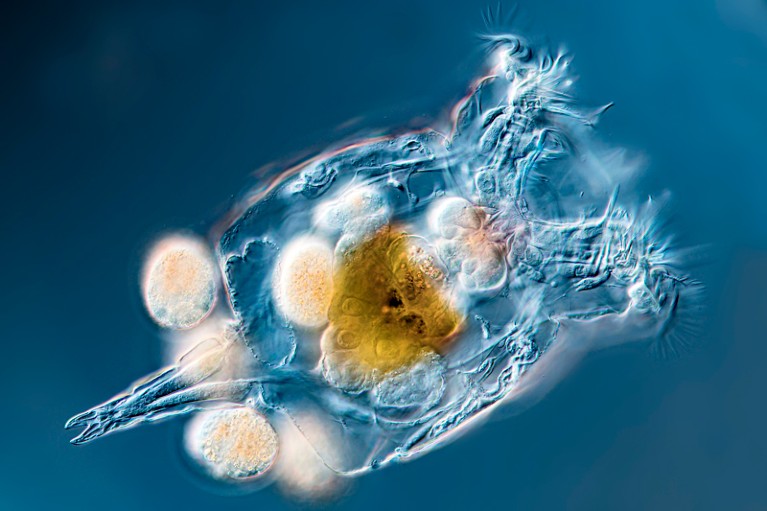
Planktonic rotifers (here shown at ×100 magnification) were one of the smallest species examined in the study on the costs of reproduction.
Credit: Frank Fox/Science Photo Library
Researchers who spoke to
Nature
said that they were generally surprised that no one had quantified indirect costs before. “Most people have said that in hindsight, it seems obvious that these costs should have existed — though no one realized they’d be so high,” Marshall adds. Still others, he says, are surprised that mathematical treatments of life had assumed such costs to be zero or low.
A lack of women in the field might have led researchers to pay less attention to the indirect costs of reproduction, Marshall suggests.
Buckley says she also doesn’t find it surprising that a field with mostly male researchers might neglect to model these costs.
Theory update
The larger energy estimates should be plugged into models of how animals live, says Asta Audzijonyte at the University of Tasmania in Hobart, Australia, who models how fish are faring amid climate change. It will take time to make these revisions, says Marshall, because rewriting the models is not straightforward. But, in turn, this could shift the weight of evidence behind some theories as to why animals live the way they do, such as whether fish hit a maximum body size to conserve energy for reproduction, he says.
Fresh estimates for reproductive energy use could also improve predictions of how species will evolve amid climate change, says Audzijonyte. This is because predictive models take into account factors such as the energy demands of reproduction, how heat alters the speed of reactions inside animals’ bodies and how big animals grow.
The study by Marshall and his team is just the first step towards quantifying the costs of reproduction across the animal kingdom, he says. Owing to scant data, the researchers often had to extrapolate the costs of pregnancy from measurements taken at just a few points during gestation, which limits the accuracy of their estimates, says Marshall. In future, studies that measure the indirect costs of reproduction throughout the entire gestation period will be needed, he says.
“Hopefully, a lot of us will put effort into better quantifying that indirect cost,” says Buckley.


